TOTTORI – Bird Catcher 鳥取県
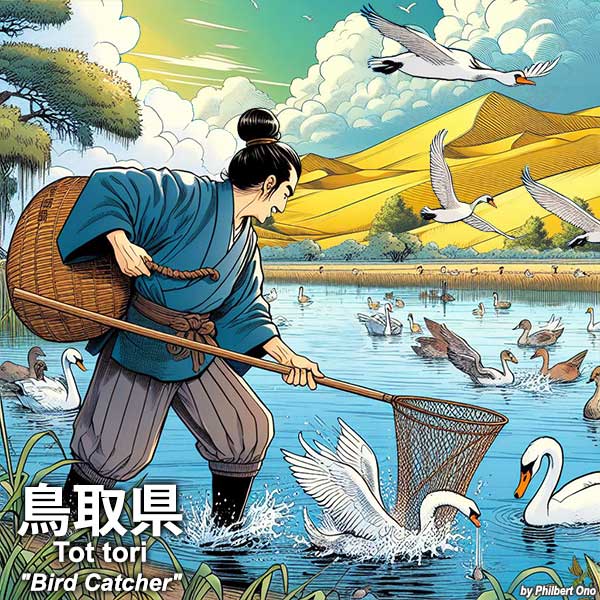
“Tottori” is one of the few prefectural names featuring an animal and the only one named after an occupation, bird catchers. This makes it quite intriguing and deserves a full investigation.
The name’s origin and meaning are mainly drawn from two historical documents, the 8th century Kojiki (Records of Ancient Matters) and Nihon Shoki (Chronicles of Japan) where the “Totori” or “Toritori” name appears.
Tottori origin stories
According to the Kojiki, ancient Tottori had bird-hunting tribes who hunted waterfowl in the plain’s many wetlands and ponds where birds gathered. When the Nara-based Yamato government came to power in the 6th to 8th centuries (Asuka Period), it ordered several wetland-rich provinces to catch and offer birds as tax payment. One of them was present-day Tottori (Inaba and Hoki Provinces). Others included Musashi (Tokyo, Saitama, Kanagawa), Mino (Gifu), Izumo (Shimane), and Bitchu (Okayama) Provinces. In the case of Tottori, the wetlands centered on the area where the Sendai River and Fukuro River merged in present-day central Tottori city.
The bird-hunting tribes were officially designated as Toritoribe or Totoribe (鳥取部), meaning “bird catchers,” under the direction of the Yamato government. (The “be,” pronounced like “bay,” means “occupation.”)
In Tottori, the bird catchers lived in Tottori city’s Mt. Kyushozan (久松山) area behind today’s Tottori Prefectural Government Office. This area was eventually named after the occupation of its residents, “Totori.” This place name stuck and later became the name of the samurai domain, the castle built on Mt. Kyushozan, the city (capital) and prefecture pronounced “Tottori.” The remains of Tottori Castle is now a tourist sight.
The Nihon Shoki narrates an interesting story behind the origin of “Tottori.”
During the reign of semi-legendary Emperor Suinin (垂仁天皇) in the 1st century, his first son, Prince Homutsuwake (誉津別王子) (or Homuchiwake in the Kojiki [本牟智和気]), remained mute even when reaching age 30. He even grew a beard, but still kept crying like baby. This greatly worried the emperor.
The prince was purported to have lost his voice due to the shock of his mother’s fiery death soon after he was born. His mother, Empress Sahohime (狭穂姫命), was urged by her older brother Prince Sahohiko (狭穂彦王) to kill her husband the emperor to allow the brother to takeover the throne.
However, as the emperor slept on her lap, she couldn’t get herself to kill him. The emperor forgave her after she confessed, but attacked and torched her conniving older brother’s castle.
The empress couldn’t bear the criticism of being responsible for the death of her brother, so she joined him in his castle under siege to commit suicide. While the castle was torched by the emperor’s forces, she came out and gave up her newborn baby, Prince Homutsuwake, to the emperor. She then died in the burning castle along with her brother. The emperor remarried one of the women his wife had recommended.
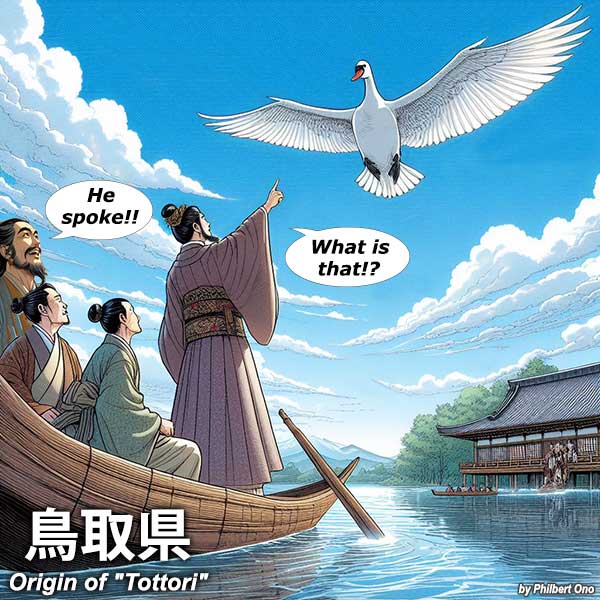
Prince Homutsuwake remained mute ever since. But one day when he and his father the emperor were on a boat on a pond, a swan flew by in the sky. The prince blurted, “What is that?”
The amazed emperor was so overjoyed in hearing his son speak that he ordered a nobleman named Ama-no-Yukawa-Tana (天湯河板挙) to catch the swan.
Ama-no-Yukawa-Tana chased the swan through different provinces and finally managed to catch it in Izumo or Tajima Province (likely in present-day Yasugi, Shimane Prefecture).
A month later, he presented the swan to the emperor. When Prince Homutsuwake played with the swan, he began speaking.
The delighted emperor rewarded Ama-no-Yukawa-Tana with the surname Totori-no-Miyatsuko (鳥取造) and also established the Totori-be (Bird Catchers 鳥取部) and Torikai-be (Bird Caretakers 鳥養部) official occupations. The bird caretakers were to take care of the birds caught by the bird catchers.
The Kojiki gives a similar story, but a different ending where the prince still did not speak when playing with the swan. The emperor was told in a dream that it was due to a curse by the Izumo God. It’s a complicated plot, so most accounts of the Tottori name’s origin refer to the story in Nihon Shoki.
Formation of modern Tottori Prefecture
During the Edo Period (17th to 19th centuries), the Tottori samurai domain consisted of Inaba and Hoki Provinces governed by the Ikeda Clan. Inaba was the eastern half of modern Tottori Prefecture (including Tottori city and Tottori Castle) and Hoki the western half. When samurai domains were abolished in 1871 by the Meiji government, the Tottori samurai domain became Tottori Prefecture.
On Aug. 21, 1876, Tottori Prefecture merged into neighboring Shimane Prefecture and the combined prefectures were called “Oshimane Prefecture” (大島根県).
However, due to the opposition of Shimane’s samurai descendants and Tottori’s strong local identity, the former Inaba and Hoki Provinces were allowed to breakaway from Shimane Prefecture on Sept. 12, 1881 to recreate the Tottori Prefecture we know today.
For five years, Tottori Prefecture did not exist. September 12 is therefore designated as “Tottori Prefecture Citizen’s Day” (とっとり県民の日) as the prefecture’s birthday.
Since Shimane and Tottori are two of Japan’s least populated prefectures (pop. 671,126 and 553,407 respectively as of 2020) whose populations continue to decline, it’s still not a bad idea for the two prefectures to merge. Proud locals may disagree though. Major points of contention would be what to name the merged prefecture and where to locate the capital.
Capturing birds in Tottori
Despite Tottori’s prefectural name, bird catching/hunting today is illegal unless you’re authorized as a wildlife researcher, etc.
The only way to capture birds in Tottori today is with your camera. Although central Tottori city no longer has expansive wetlands like before, rivers and bodies of water do remain in the city and prefecture where birds gather, including migratory birds like swans and ducks.
One of Tottori’s best birdwatching spots is Yonago Waterbird Sanctuary (米子水鳥公園) in Yonago, a city on the western end of Tottori Prefecture next to Shimane Prefecture fronting Lake Nakaumi. The waterbird park is a wetland on the fringe of Lake Nakaumi where 42% of Japan’s bird species can be found.
There’s a birdwatching station for people to observe migratory tundra swans in winter as well as ducks, herons, white-fronted geese, brown-bellied geese, and white-tailed eagles. The park is open 9 a.m. to 5:30 p.m. on weekdays and 7 a.m. to 5:30 p.m. on weekends and national holidays. Buses run from JR Yonago Station.
Tottori’s bird symbols

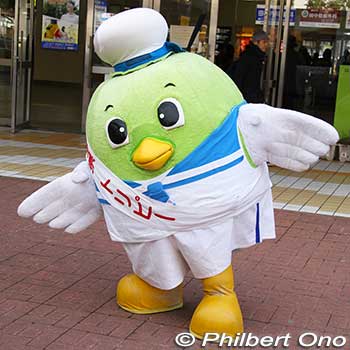
Right: Official mascot, Toripy (in front of Tottori Station).
Tottori continues to play up its bird connection with its prefectural crest (set in 1968), prefectural flag, and official mascot all having a bird motif.
The prefectural crest is based on a stylized hiragana “to” (と) character for tori (bird). Although the bird species is not stated, it looks like a dove or pigeon (symbol of peace). This crest also appears on the prefectural flag.
Tottori Prefecture’s official mascot is Toripy (トリピー), a cute bird with the body of a Japanese pear in a sailor’s uniform. The pear (nashi) is a specialty of Tottori, namely the variety called Nijisseiki (二十世紀) which looks more greenish than the usual yellow-brown. The mascot was created for a small local expo in Tottori named San’in Yume Minato Expo (山陰・夢みなと博覧会) held in Sakaiminato during July–September 1997.
Old province names: Inaba-no-Kuni, Hoki-no-Kuni (因幡国+伯耆国)
*The AI-generated image is for illustrative purposes only and may not accurately depict any particular place or person in the prefecture.
Sidebar: Japan’s affinity with birds
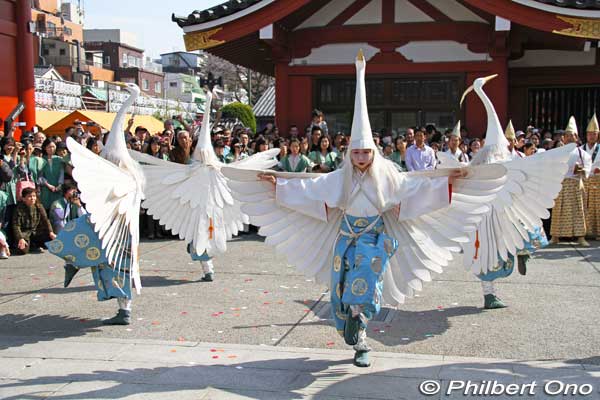
Although “Tottori” is the only prefectural name having a bird (tori) meaning, there are other well-known place names in Japan with a reference to birds. In Yokohama, there’s “Tsurumi” (鶴見) meaning “crane spotting.” In Kawasaki, Kanagawa, “Saginuma” (鷺沼) means “heron marsh.”
There are also Japanese personal names containing “bird” such as “Shiratori” (白鳥 White Bird), “Torigoe” (鳥越), and “Tsuruta” (鶴田 Cranes in Rice Paddy).
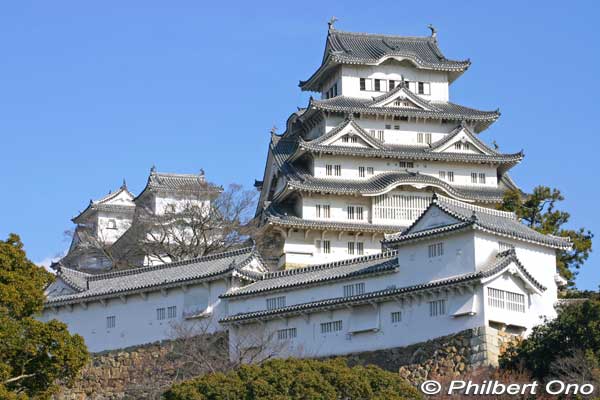
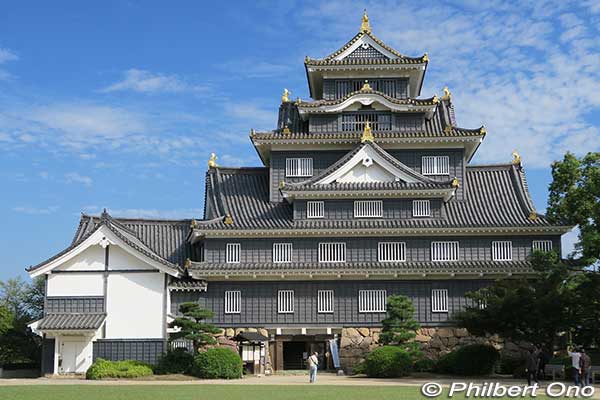
There are buildings and vehicles named after birds. National Treasure Himeji Castle in Hyogo Prefecture is nicknamed “White Heron Castle” (Shirasagi-jo 白鷺城). In contrast, Okayama Castle in Okayama Prefecture is nicknamed “Raven Castle” (Karasu-jo) due to its black exterior.
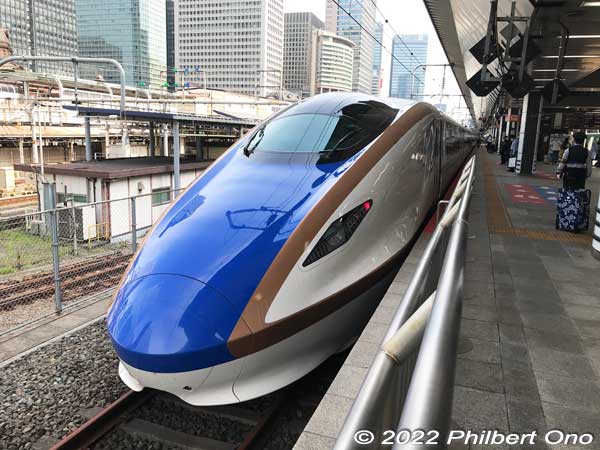
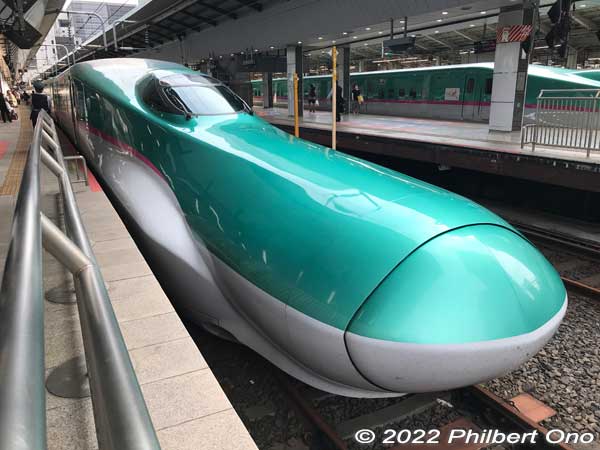
Japan has many express trains named after birds and no other animals. The JR limited express train (tokkyu) running between Nagoya (Aichi) and Kanazawa (Ishikawa) is named Shirasagi (しらさぎ) or “White Heron,” and the one running between Osaka and Kanazawa/Tsuruga is named Thunderbird, a literal translation of raicho (雷鳥), a grouse (rock ptarmigan) found in the Tateyama mountains in Toyama Prefecture.
Among the shinkansen bullet trains, the Joetsu Shinkansen has Toki (crested ibis) trains running between Tokyo and Niigata, Hokkaido Shinkansen has Hayabusa (Peregrine falcon) trains between Tokyo and Shin-Hakodate-Hokuto, Kyushu Shinkansen has Tsubame (swallow) trains between Hakata and Kumamoto/Kagoshima-Chuo, Hokuriku Shinkansen has Hakutaka (white hawk) trains between Tokyo and Kanazawa, and Nishi Kyushu Shinkansen has Kamome (seagull) trains between Hakata and Nagasaki.

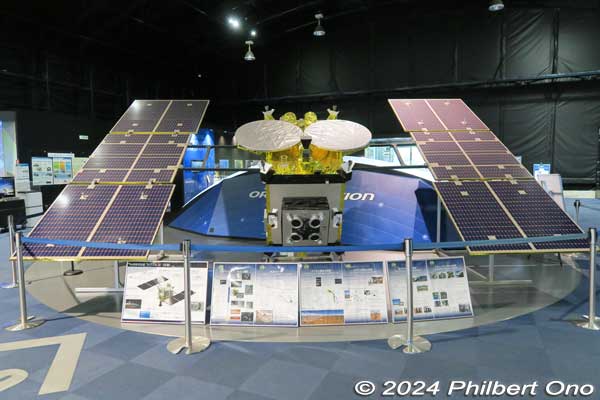
Japan’s expendable cargo spacecraft for delivering supplies and experiments to the International Space Station (ISS) from Sept. 2009 to Aug. 2020 was nicknamed Kounotori (Oriental White Stork) which can mean “bird of happiness.”
Hayabusa and Hayabusa2 are the names of Japan’s space mission to obtain asteroid samples back to Earth. Hayabusa means Peregrine falcon, known for its high speed.
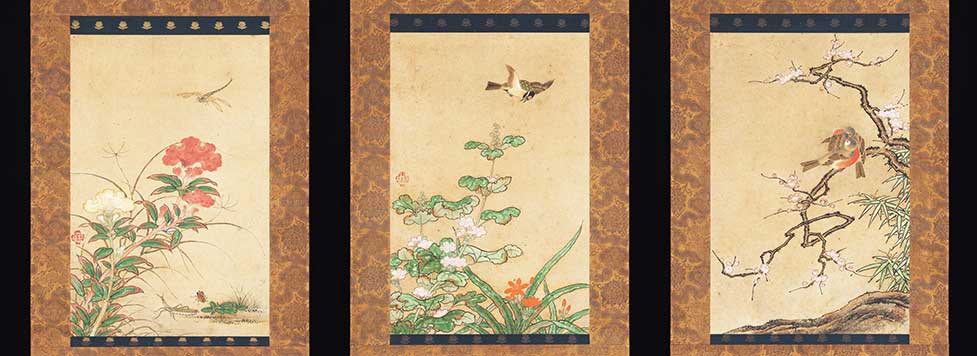
Japan has a long and fascinating history with birds in religion, culture, art, and food. The chicken or rooster was likely the earliest bird which the ancient Japanese interacted with. But it was originally not for the meat nor eggs, but for religious purposes and divinations by examining the chicken bones or holding cockfights.
Birds, like certain other animals, were considered to be sacred as a manifestation of the gods in the wondrous, natural world (animism). Seeing them flying in the air made them look closer to the gods. Even the legend of Yamato Takeru has his spirit fly away as a white bird after his death. (See origin of “Mie Prefecture“.)
There is evidence that the first birds that the ancient Japanese (Jomon Period until 300 BC) consumed were ducks and pheasants. During the Yayoi Period (until 300 AD), they also consumed cranes found on wetlands. Chickens/roosters were also domesticated by then, but they were mainly used to tell time.
By the Heian Period (794–1185), birds started to become part of the Japanese diet. And by the early Edo Period (17th to mid-19th centuries), a wide variety of birds were being consumed including cranes, swans, geese, ducks, pheasants, herons, pigeons, and chicken. Through Nagasaki, the only port opened to foreign trade, the upper class were importing colorful and exotic birds to keep as pets.
Birds have long been a major element in Japanese art especially when depicted together with flowers (花鳥画 kachoga), a major genre of painting. As of this writing, I still haven’t found any old painting depicting Tottori’s traditional waterfowl catchers.
There are 700+ species of birds in Japan. Each prefecture has an official bird. Tottori Prefecture’s official bird is the Mandarin duck (オシドリ). The most beloved birds in Japan are the cranes, storks, kingfishers, swans, falcons, and egrets/herons.
Sources:
- https://www.pref.tottori.lg.jp/172946.htm
- https://www.pref.tottori.lg.jp/1412.htm
- https://ja.wikipedia.org/wiki/%E9%B3%A5%E5%8F%96%E7%9C%8C#%E7%9C%8C%E5%90%8D%E3%81%AE%E8%B5%B7%E6%BA%90%E3%81%AB%E3%81%BE%E3%81%A4%E3%82%8F%E3%82%8B%E8%AA%AC%E8%A9%B1
- https://ja.wikipedia.org/wiki/%E5%A4%A9%E6%B9%AF%E6%B2%B3%E6%9D%BF%E6%8C%99
- https://haruaki.shunjusha.co.jp/posts/976
- https://note.com/yamada1983taro/n/n83754d7c3661
- https://goopass.jp/animal/bird/bird-tottori
Origin of other prefectural names (etymologies)
Overview | Aichi | Akita | Aomori | Chiba | Ehime | Fukui | Fukuoka | Fukushima | Gifu | Gunma | Hiroshima | Hokkaido | Hyogo | Ibaraki | Ishikawa | Iwate | Kagawa | Kagoshima | Kanagawa | Kochi | Kumamoto | Kyoto | Mie | Miyagi | Miyazaki | Nagano | Nagasaki | Nara | Niigata | Oita | Okayama | Okinawa | Osaka | Saga | Saitama | Shiga | Shimane | Shizuoka | Tochigi | Tokushima | Tokyo | Tottori | Toyama | Wakayama | Yamagata | Yamaguchi | Yamanashi